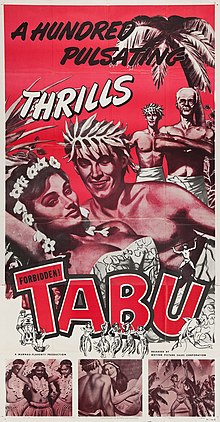| Tabu: A Story of the South Seas | |
|---|---|
 Poster for 1949 U.S. theatrical re-release | |
| Directed by | F. W. Murnau |
| Written by | F. W. Murnau Robert J. Flaherty |
| Produced by | David Flaherty Robert J. Flaherty F. W. Murnau |
| Starring | Matahi Anne Chevalier Bill Brambridge |
| Cinematography | Floyd Crosby |
| Edited by | Arthur A. Brooks |
| Music by | Hugo Riesenfeld |
| Distributed by | Paramount Pictures |
Release date |
|
Running time | 84 minutes |
| Country | United States |
| Languages | Sound (Synchronized) English Intertitles |
| Budget | $150,000 |
| Box office | $472,000 |
Tabu: A Story of the South Seas, sometimes simply called Tabu (pronounced [ˈtapu]), is a 1931 American synchronized sound film directed by F. W. Murnau. While the film has no audible dialog, it was released with a synchronized musical score with sound effects using the Western Electric Sound System sound-on-film process. A docufiction, it is split into two chapters: The first, called "Paradise", depicts the lives of two lovers on a South Seas island until they are forced to escape the island when the girl is chosen as a holy maid to the gods. The second chapter, "Paradise Lost", depicts the couple's life on a colonised island and how they adapt to and are exploited by Western civilisation. The title comes from the Polynesian concept of tapu (spelled tabu in Tongan before 1943), from which is derived the English word "taboo".
The story was written by Robert J. Flaherty and Murnau; with the exception of the opening scene, the film was directed solely by Murnau. This was his last film; he died in a hospital after an automobile accident on March 11, 1931, a week before the film's premiere in New York City.
Cinematographer Floyd Crosby won an Academy Award for Best Cinematography for his work. In 1994, Tabu: A Story of the South Seas was selected for preservation in the United States National Film Registry by the Library of Congress as being "culturally, historically, or aesthetically significant".